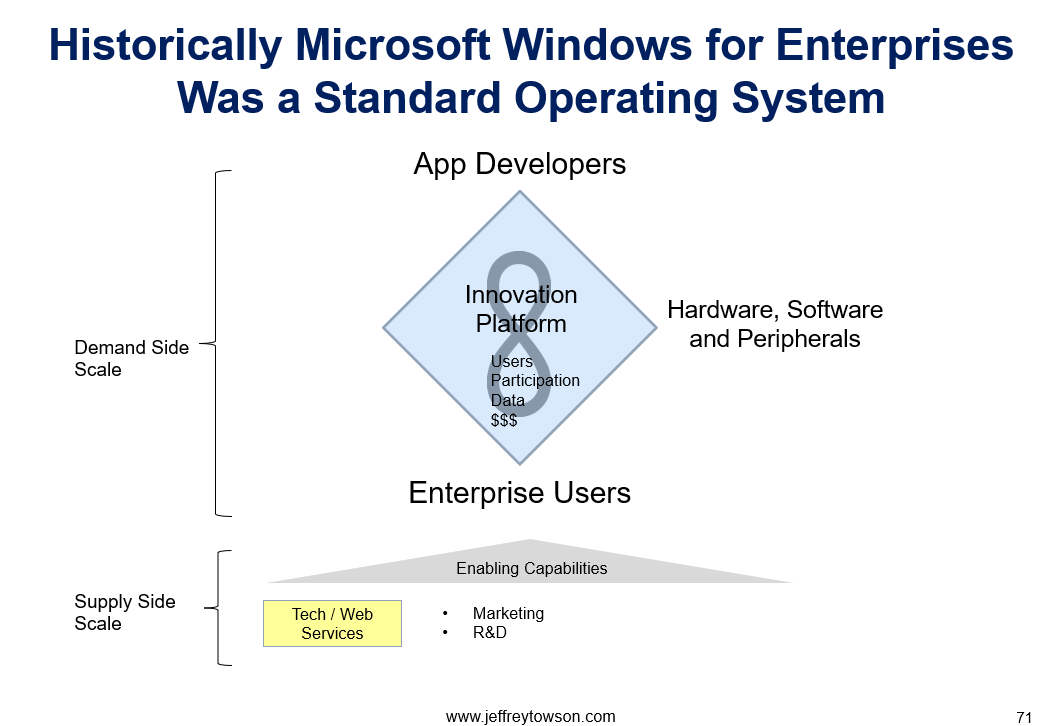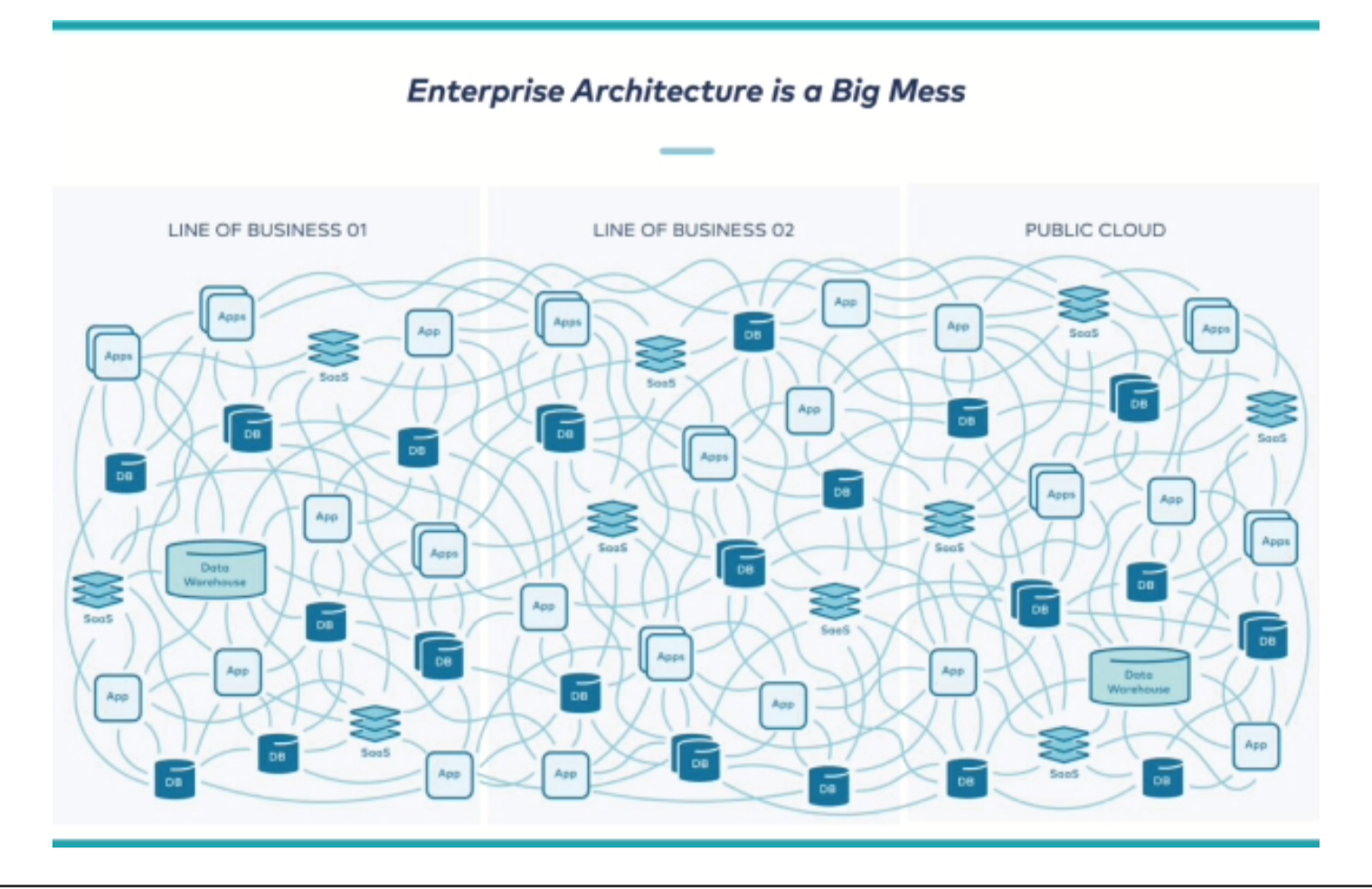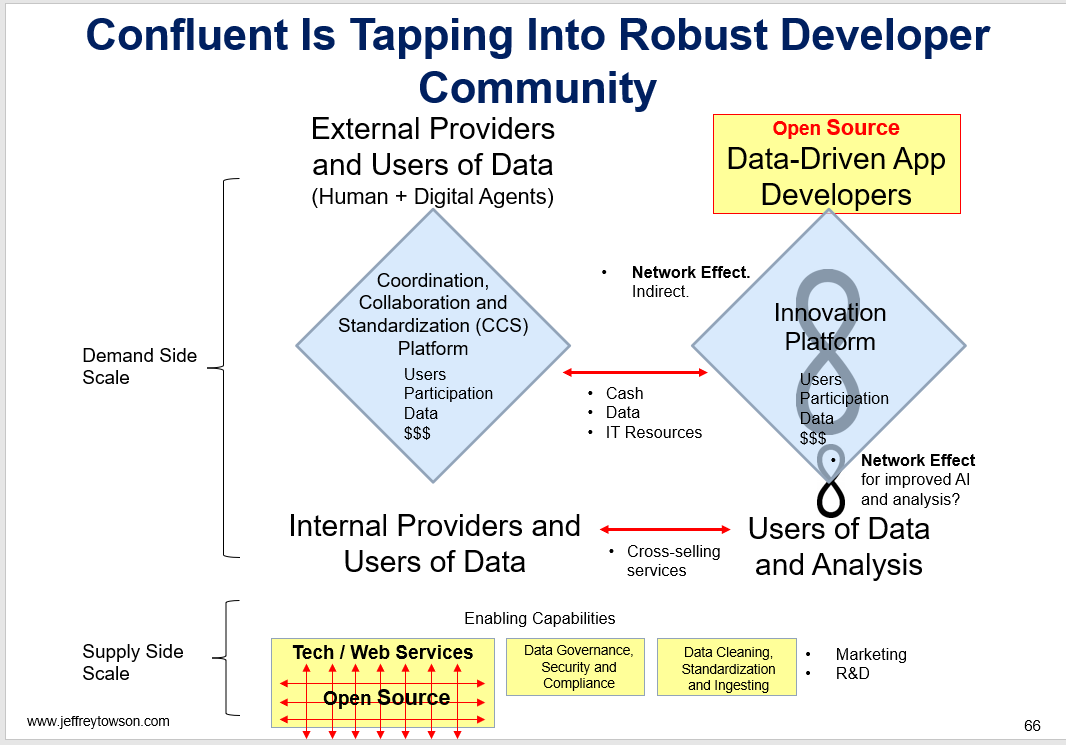In Part 1, I discussed Snowflake and its compelling business model for a “data ecosystem”. I argued it was a collaboration (CCS) platform based on data intelligence. Plus some other stuff. And I also outlined 4 types of collaboration platforms, which were:
- Communication. Zoom, Slack, etc.
- Data Intelligence. Snowflake and Confluent
- Team Projects. Manual and complicated projects like architecture, media creation, software development.
- Operational Automation.
This is me trying to breakdown collaboration platforms, which are common in B2B enterprise software. I have detailed out quite a few types of marketplace platforms (services, products, digital goods). But collaboration platforms needed more detail. I think the frameworks are getting much clearer. You can see Snowflake building a collaboration platform and combining it with an innovation platform (in my opinion).
However, Snowflake has some interesting competitors. Definitely the big cloud platforms AWS, Azure and Google Cloud. But there is also Confluent, which is an interesting approach to the same business using open source databases. That is a fascinating twist on all this. I’ll get into that but first a detour into Red Hat.
An Introduction to Red Hat
There is a lot of focus on the newer, bigger and/or faster growing digital companies, like Facebook and ByteDance. But there are a decent number of old school software companies that have been quietly chugging along for decades. They aren’t on the cutting edge. They aren’t surging or making the news. But they’re really interesting because of their profits and longevity. It’s an interesting question. What types of business models can last +30 years in digital and software?
I wrote a bit about Adobe for this reason. Another long-enduring, old school software company is Red Hat. Founded in 1993, Red Hat is almost 30 years old. Although it was acquired by IBM for $34B in 2018-2019, so technically its life as a stand-alone software company has ended.
North Carolina-based Red Hat is mostly associated with its enterprise operating system Red Hat Enterprise Linux. This has been their core product forever. It is an operating system for enterprises based on the open-source Linux kernel. Large companies around the world have been using this as a replacement and sometimes a complement to proprietary enterprise operating systems, such Microsoft.
Red Hat offers some other infrastructure-type products and lots of app development tools. But it is the enterprise operating system that is most of the business. And the reason for their longevity. Over time, the product has shifted from licenses to subscriptions. It has also transitioned from on premise server software to cloud based (and hybrid) software. That has been pretty common in enterprise software.
What makes Red Hat so different is the open source approach. It’s a super important idea I haven’t really spoken much about. Looking at Red Hat, you can see three really important decisions by management.
- Sell an open source created product. The company uses a “community-powered approach for developing reliable, high performing operating systems”. That means it uses the collective input, resources and knowledge of contributors around the world – who collaborate to develop, maintain and enhance the software. In this case, it is built on Linux. Recipients can see the source code, inspect it, suggest changes, customize and enhance.
- Distribute with an open source licensing agreement. The company distributes under an open-source license, such as General Public License (GPL) and Lesser General Public License (GNU). This means others are free to use it, copy it, modify it and redistribute it. It provides broad rights to the users. It also creates far greater transparency and choice, relative to proprietary software. You cannot modify the Microsoft source code. Generally, you can also only see the machine-readable code and not the human readable.
- Sell a subscription business model. The company sells annual and multi-year subscriptions for support and additional features. It is also selling some on-demand services.
It’s worth really thinking about how powerful open source is as a capability. Microsoft can hire tens of thousands of employees, with lots of developers. But could any firm match the global talent in software and development that an open source project can access? The community can see and further develop and adapt the code themselves for new products. It can take apart the openly viewable code when there is a bug or issue. It’s such a powerful idea.
If we consider Microsoft Operating System for Enterprise (circa 1995) to be an innovation platform, we could do a simple representation like this.

In comparison, Red Hat would look like this:

We can basically show Red Hat tapping into a different and much larger capability for enabling the interactions of on the platform.
It also changes the product offering to users. Think of the benefits to Red Hat’s customers (versus a proprietary system like Microsoft):
- It provides access to the binary and source code with broader rights to copy, modify and redistribute.
- There is far greater flexibility than proprietary protocols and formats. A company can change the code and adapt the product for its own operations.
- It enables in-house development team to collaborate and innovate with a global community of developers and testers.
- It enables ongoing and quicker access to fixes and improvements. There is total ability to inspect and diagnose problems.
It all sounds too good to be true. Which is also true.
The problem with accessing the free labor and collaboration of a global community is they don’t actually work for you. And you only have limited control of the development of the product. Red Hat has to always check its commercial activities against what the community may or may not like. That severely limits their range of action. Red Hat also has to work with the community to steer the direction of development. But it can only influence and support.
So Red Hat has some activities that we really only see in open-source companies. For example, they are active sponsors of open-source projects. They are engaged in these communities to support the use of these systems. Red Hat sponsors open-source projects and contributes to others, including the Apache Kernel used by Confluent.
***
Ok. That brings us back to Snowflake vs. Confluent. What happens when you use the power of open source in a data intelligence collaboration platform like Snowflake?
An Introduction to Confluent
Confluent was founded in 2014 as an open source approach to databases. Its client list has increased from 1,000 to 2,500 (2020 to 2021). Its revenue has grown 51% (2021). So it’s a small company but showing growth. Here are the financials.

The company is pretty similar to Snowflake. It is about providing data intelligence within an organization. But it uses somewhat different language. Confluent talks about:
- Using “data infrastructure” to connect all the applications, systems, and data layers in a company in a real-time central nervous system.
- It is an “end-to-end reimagining of business”, where data flowing in real-time from every source enables apps. This improves real time customers experiences and data-driven business operations.
- What matters is the data flows within an organization, so the company talks about “data in motion.”
This is how they illustrate traditional databases in large companies.

They argue this becomes more and more inefficient as data volumes and speeds increase. So they argue for a common standard.

Confluent also cites two main use cases for companies.
- Enabling data rich, front-end customers experiences. The company talks about how increased data intelligence can create rich and personalized experiences based on real-time data.
- Software-driven, back end operations that enable greater efficiency and speed. For example, better management of inventory and better run factories with IoT sensors.
For those that have been following my writing, this should sound really familiar. These are basically two of my Digital Operating Basics.
- DOB2: Never-Ending Personalization and Customer Improvements
- DOB3: Digital Core for Management and Operations
So Confluent, like Snowflake, is helping businesses go digital and are leading with these two Digital Operating Basics. That is actually what we see companies do when they first go digital.

Does an Open Source Approach Work with a Data Intelligence Collaboration Platform?
This is really the key question I think.
It helps that the founders of Confluent involved in the creation of Apache Kafka, an open source database system. The company says +70% of Fortune 500 companies use Apache Kafka – and the myriad of apps that integrate with it. So it’s an open source contrast to Snowflake’s propriety approach.
If you map out the business model, it looks pretty similar to Snowflake, with the same difference we just saw in Red Hat.


You could also argue that open source is different in the complementary innovation platform.


There is a lot of technology that goes into Apache Kafka and database systems. I’m not going into that. I just wanted to tee-up what a big but confusing thing open source can be when you integrate it into a business model. The above pictures is how I see it.
As for Confluent, in my opinion, it’s a far too uncertain for me to predict. Their use of open source is a powerful tool that can create a much better service – but it also a more difficult business model to build and to manage. I put this company as a good lesson in business models. But also into my “too hard” bucket as a company.
Cheers, Jeff
–—
Related articles:
- Snowflake, Red Hat, Confluent and 4 Types of Coordination Platforms (1 of 2)(Asia Tech Strategy – Daily Article)
- Part 3: Snowflake’s Big Growth and Competition Questions (Pt 3 of 3) (Asia Tech Strategy – Daily Lesson / Update)
- Snowflake is Building 3 Complementary Platforms with 4 Network Effects (Pt 1 of 3) (Asia Tech Strategy – Daily Lesson / Update)
From the Concept Library, concepts for this article are:
- Coordination Platforms
- Coordination Platforms: Data Intelligence
- Enterprise B2B
- Open Source
From the Company Library, companies for this article are:
- Confluent
- Red Hat
Photo by Zdeněk Macháček on Unsplash
——-
I write, speak and consult about how to win (and not lose) in digital strategy and transformation.
I am the founder of TechMoat Consulting, a boutique consulting firm that helps retailers, brands, and technology companies exploit digital change to grow faster, innovate better and build digital moats. Get in touch here.
My book series Moats and Marathons is one-of-a-kind framework for building and measuring competitive advantages in digital businesses.
This content (articles, podcasts, website info) is not investment, legal or tax advice. The information and opinions from me and any guests may be incorrect. The numbers and information may be wrong. The views expressed may no longer be relevant or accurate. This is not investment advice. Investing is risky. Do your own research.

